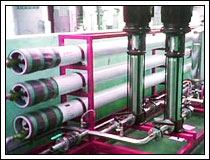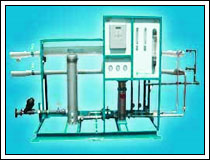Reverse Osmosis Systems
Reverse Osmosis Systems are water treating or filtering plants/units that functions on the phenomenon of reverse osmosis. Reverse Osmosis removes many types of large molecules and ions from solutions; a selective membrane is used for the purpose. The solution of water and unwanted solute is kept in one side of the membrane and then high pressure is put on it, eventually, the solute is retained on the pressurized side of the membrane and the pure solvent (here water) passes to the other side.

Reverse Osmosis Water Purification Unit
A reverse osmosis water purification unit, acronym as ROWPU, is a portable and self-contained water treatment plant. It is industrially used to transform water from any source into potable water.
The Treatment Process
The process begins as soon as the raw water is pumped into the ROWPU unit and is treated with a polymer to initiate coagulation. After that, the coagulated water is passed through a multi-media filter where it undergoes ion exchange. From there the water is pumped through a spiral-wound cotton cartridge filter. By the end of these steps, water gets rid of any particles larger than 5 micrometers (0.00020 in) and also losses almost all turbidity. The clarified water is then fed through a high-pressure piston pump into a series of vessels where it is subject to reverse osmosis. The final water, obtained after the treatment of reverse osmosis, is free of 90.00% - 99.98% of the raw water's total dissolved solids. It is then disinfected with chlorine and stored for later use.
Reverse Osmosis water purification units were initially designed for the military use, so that forces can have potable water even in those places where there is a sacristy of safe and pure water. The United States armed forces and the Canadian Forces possess different models of these units; some models are containerized, some are trailers, and some are vehicles unto themselves. In United States, each branch of armed forces has similar but its own series of ROWPU models.
A Reverse Osmosis Plant

Reverse Osmosis Plant is a plant where the process of reverse osmosis is carried out for water treatment. Like Reverse Osmosis Water Purification Units, these plants are not portable and exist in countable number. At present, the Reverse Osmosis Plant of Israel at Ashkelon on the Mediterranean coast, is the largest plant under operation and producing 320,000 cubic meters of water a day at around possibly $0.50 USD per cubic meter. However, a few plants are under construction like, in China a desalination plant will be built for Tianjin, to produce 100,000 cubic meters of desalinated seawater a day and in Spain 20 reverse osmosis plants will be built along the Costas, expecting to meet slightly over 1 per cent of Spain's total water needs.
The major challenge for these plants is to find ways to reduce its energy consumption. Normally, an average modern reverse osmosis plant needs six kilowatt-hours of electricity to desalinate one cubic meter of water, which is quite high. Other challenges associated with these plants are that they produce large amount of salty briny waste, hence there is the need for improvement in the process of desalination and also some innovation is required in the area of waste management to deal with the waste.
|